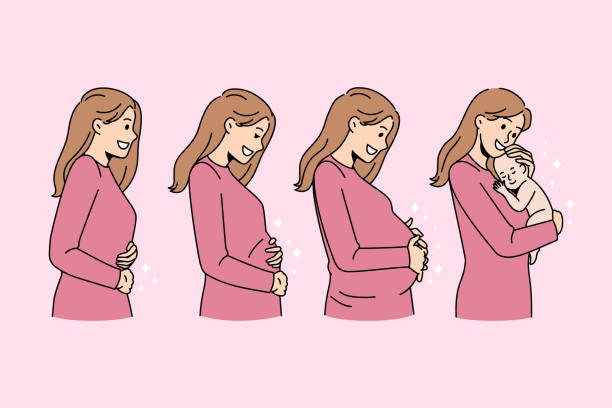Back
How Do I Fix My Body and Posture After Pregnancy?
By Dr. Christine Martirez PT, DPT on 6/5/2024

Pregnancy and childbirth bring about incredible changes in a woman’s body, affecting muscles, posture, and overall physical function. Many new mothers experience issues such as "mom butt," weakened abdominal muscles, and pelvic floor dysfunction. This blog post will explore what "mom butt" is, the muscles affected postpartum, and how pelvic floor physical therapy can help you regain strength and proper posture after giving birth.

Understanding "Mom Butt"
"Mom butt" is a term often used to describe the loss of gluteal muscle tone and definition after pregnancy. It can occur due to a combination of factors:
Postural Changes:
Pregnancy often leads to an anterior pelvic tilt, where the pelvis tilts forward, causing the gluteal muscles to lengthen and weaken.
Carrying Posture:
Carrying by gripping the glutes and having a backwards lean is a common posture within the presence of abdominal and core weakness.Weight Gain:
The additional weight carried during pregnancy can alter walking patterns and biomechanics, contributing to decreased gluteal engagement.
Muscle Imbalances:
Hormonal changes and the physical demands of pregnancy can lead to muscle imbalances, particularly in the core and lower body.
Muscles Affected Postpartum
Pelvic Floor Muscles:
The pelvic floor muscles support the bladder, uterus, and rectum. They undergo significant strain during pregnancy and childbirth, leading to potential weakness, tears, and dysfunction. Issues such as urinary incontinence and pelvic organ prolapse are common postpartum concerns.
Abdominal Muscles:
Rectus Abdominis:
This muscle can separate during pregnancy, a condition known as diastasis recti, which results in a gap along the midline of the abdomen.
Internal and External Obliques:
These muscles also stretch and weaken, impacting core stability.
Transverse Abdominis:
The deepest layer of abdominal muscles, crucial for core stability, often becomes weak and less engaged postpartum.
Gluteal Muscles:
The glutes, including the gluteus maximus, medius, and minimus, can lose strength and tone due to altered posture and biomechanics during and after pregnancy. This contributes to the appearance of "mom butt."
How Pelvic Floor Physical Therapy Can Help
Pelvic floor physical therapy (PFPT) is a specialized form of physical therapy aimed at addressing the changes and dysfunctions that occur in the pelvic region. Here’s how PFPT can help restore your body and posture after pregnancy:
Comprehensive Evaluation:
Subjective and Medical History:
The therapist will take a detailed history of your pregnancy, delivery, and postpartum symptoms.
Physical Assessment:
This includes evaluating your posture, alignment, and movement patterns to identify muscle imbalances and areas of weakness.
Pelvic Floor Muscle Training:
Pelvic Floor Exercises:
Targeted exercises to strengthen the pelvic floor muscles, such as Kegels, can help improve muscle tone and function. Biofeedback may be used to enhance muscle control and coordination.
Manual Therapy:
Hands-on techniques like myofascial release and soft tissue mobilization can help reduce muscle tension and improve circulation in the pelvic region.
Abdominal Muscle Rehabilitation:
Diastasis Recti Exercises:
Specific exercises to close the gap between the rectus abdominis muscles and strengthen the transverse abdominis. These exercises often focus on gentle core activation and proper breathing techniques.
Core Strengthening:
A holistic approach to strengthening the core, including the obliques and transverse abdominis, to restore stability and support for the spine and pelvis.
Gluteal Muscle Strengthening:
Targeted Exercises:
Exercises like bridges, clamshells, and squats to activate and strengthen the gluteal muscles, improving their tone and function.
Postural Corrections:
Education on proper posture and body mechanics to ensure the glutes are effectively engaged during daily activities and exercise.
Lifestyle and Behavioral Modifications:
Posture and Body Mechanics Education:
Teaching proper posture and movement patterns to reduce strain on the pelvic floor and other muscles.
Bladder and Bowel Habits:
Guidance on healthy bladder and bowel habits to manage symptoms like urinary incontinence.
Pain Management:
Strategies to manage pain and discomfort, including relaxation techniques and supportive devices if needed.
Postpartum recovery involves addressing the myriad changes that occur in the body during pregnancy and childbirth. "Mom butt," weakened abdominal muscles, and pelvic floor dysfunction are common issues that can be effectively managed with the help of pelvic floor physical therapy. Through a comprehensive evaluation and personalized treatment plan, PFPT can help you regain strength, improve posture, and enhance overall physical function. By working with a skilled pelvic floor physical therapist, you can navigate the postpartum period with confidence and support, restoring your body to optimal health and well-being.
Read More:
How Chronic Pelvic Congestion in Men Contributes to Prostatitis By Shannon Strauch, PTA, STMT-1 on 12/11/2024 How lymphatic issues can cause symptoms of prostatitis Prostatitis and Tight Pelvic Floor Muscles: A Comprehensive Guide By Shannon Strauch, PTA, STMT-1 on 12/10/2024 How a tight pelvic floor can be the reason for prostatitis symptoms
Are you ready to live pain free?
Request An Appointment